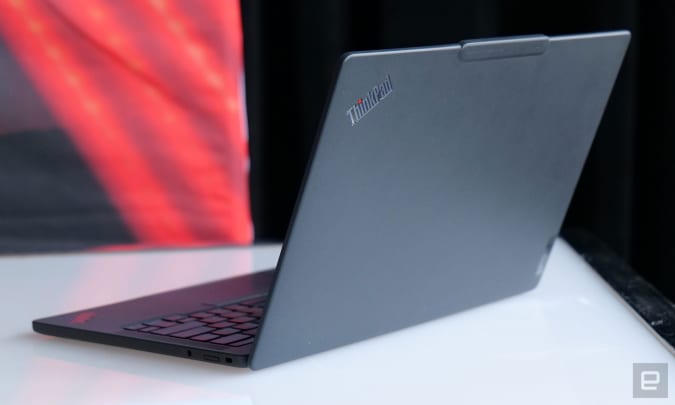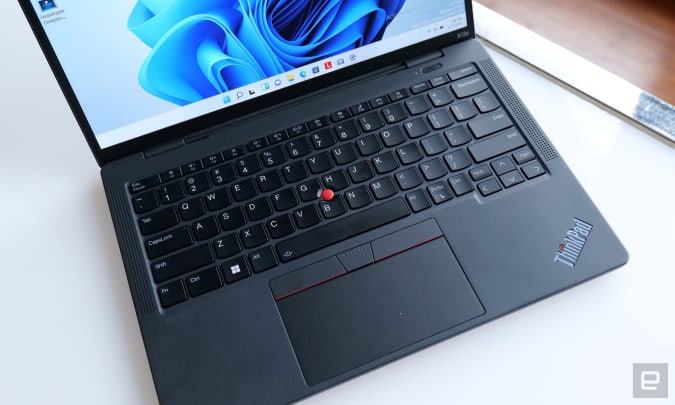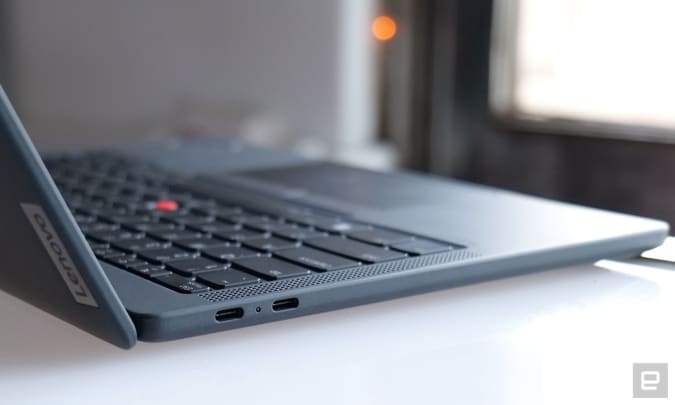Unlike Apple’s M1 MacBooks, ARM-based Windows on Snapdragon laptops haven’t enjoyed quite the same level of success or popularity. But Lenovo is hoping to change that – at least for enterprise customers – with the new ThinkPad X13s.
The ThinkPad X13s’ secret weapon is its , which Lenovo says is the first time Qualcomm’s newest laptop processor has been featured in a commercial device. By leveraging improved energy efficiency and a low-power 400-nit 13.3-inch display, Lenovo says the ThinkPad X13s can last up to 28 hours on a single charge. That said, I’m going to want to confirm this myself, because I’ve definitely been burned by shorter-than-expected longevity on previous Windows on Snapdragon machines.

Sam Rutherford/Engadget
In keeping with the ThinkPad X13s’ focus on mobile productivity, the laptop also features a fanless design while weighing just 2.5 pounds, with top and bottom panels made from 90 percent recycled magnesium. And to make sure you have a speedy internet connection wherever you go, the laptop also supports 5G (both sub-6GHz and mmWave) and WiFi 6E. Other specs include up to 32GB of RAM, up to 1TB of PCIe storage, and two USB-C 3.2 Gen 2 ports (but no Thunderbolt 4, cause that’s an Intel thing).
Inside, the laptop comes pre-installed with Windows 11 Pro, with Lenovo relying on a number of Qualcomm’s collaboration features like AI-based auto-framing for its 5MP webcam and intelligent noise suppression that works with the laptop’s triple microphone setup. There’s even a human presence detection feature that can automatically dim or turn off the laptop’s display when it detects that you have looked away to protect sensitive data from prying eyes.

Sam Rutherford/Engadget
Now I know I’m not exactly Lenovo’s target audience for the ThinkPad X13s, and I probably wouldn’t buy a Windows on Snapdragon laptop for myself since they often struggle to run games (even casual titles). But even so, during my brief hands-on time with the device, I found that there’s a lot to like. Its design is quite sleek even by ThinkPad standards, while its magnesium chassis adds durability without a significant increase in weight. And of course, there’s that claimed 28 hours of battery which should last for days of real-world use (assuming the laptop can live up to Lenovo’s figures).
The only issue I noticed during my brief time with the notebook was a touchpad that felt softer and spongier than I’d like. Though since it’s a ThinkPad, you can always use Lenovo’s iconic TrackPoint nub instead. Thankfully, the X13s’ keyboard felt crisp with plenty of key travel, so there shouldn’t be much of a learning curve for ThinkPad diehards.

Sam Rutherford/Engadget
For a low power display, the laptop’s screen is admirably bright, and the auto-framing camera worked like a charm, even if it was a touch too aggressive zooming in and out when I moved my head back and forth. You even get built-in IR cameras for facial recognition and Windows Hello face login. And thanks to the App Assure program, enterprise customers can get help directly from Microsoft to ensure all of a company’s corporate software runs smoothly on the X13s’ Arm-based processor.
So despite a bumpy reception for previous Windows on Snapdragon machines, between the Snapdragon 8cx Gen 3 and Lenovo’s willingness to put that chip in a ThinkPad for the first time, we could be looking at a new era for ARM-based Windows notebooks.
The ThinkPad X13s is slated to go on sale sometime in May starting at $1,100.
Catch up on all of the news from MWC 2022 right here!
All products recommended by Engadget are selected by our editorial team, independent of our parent company. Some of our stories include affiliate links. If you buy something through one of these links, we may earn an affiliate commission.
Credit: Source link


Comments are closed.